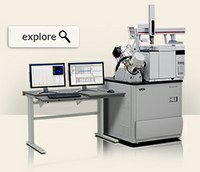The CREAM Mass Spectrometry Facility houses a unique combination of mass spectrometers that can be harnessed to implement various analytical projects, typically is capable of achieving glaboal metabolic profiling, targeted metabolomics, and atom-resolved biochemical analysis of metabolite isotopologues, in both qualitative and quantitative profiles. Due to the analytical power of each MS, plus the extremely wide range of applications represented by the combination, many problems outside of metabolomics can also be addressed.
IonCyclotronMSstock
Tandem MS-filtered Fourier transform ion cyclotron resonance mass spectrometer (7.0 Tesla) (MS-FTICR-MSn)
(LTQ FT, Thermo Electron Corp.)
The hybrid MS-FTICR-MSn with front-end tandem mass spectrometer offers ultrahigh-accuracy (ca. ~1.0 ppm) with ultrahigh resolution (R=100-400K), and is physically combined with a plateform of linear ion trap mass spectrometer (LTQTM description see below) (Thermo Electron Corp.). The ICR cell is also functioned with:
- Infrared multi-photon dissociation (IRMPD) fragmentation MSn
- Electron-capture dissociation (ECD) fragmentation MSn
The MS-FT-MSn system provides confident capabilities for various high resolution analyses for complex microcosmic structure identification and quantification, including accurate mass and isotopomer distribution, of a wide range of small molecules and proteins, their metabolites and turnover pathways, and so on.
Nanospray Image
Linear ion trap mass spectrometer (LTQ)
(LTQTM, Thermo Electron Corp.)
The LTQ™ is a two dimensional (2D) linear ion trap mass spectrometer with unique features, and represents a major leap in ion trap technology from the traditional 3D quadrupole ion traps. The LTQTM mass spectrometer is a hybrid platform of MS-FTICR-MSn and coupled with various ion sources and sample introduction and separation systems, including:
- Nano electrospray ionization source (ESI)
- Automated chip-based nozzles nanomate ESI system (TriVersaTM, Advion)
- Atmospheric pressure matrix-assisted laser desorption/ionization (AP-MALDI)
- Atmospheric pressure chemical ionization (APCI)
- Atmospheric pressure photo ionization (APPI)
- Collision-induced dissociation (CID) MSn in the linear ion trap
- 1D and 2D LC systems with conventional, micro and nano flow (Ultimate 3000)
- UV-visible wavelength detector with sub-microliter cell (Ultimate 3000)
The LTQTM system can be used alone or in combination with FTICR-MS, and has the individual and integrated complementary benefits as a reliable tool for structural identification and quantification in complex matrices, such as protein identification and quantitative differential expression analysis; biomarker studies and post-translational modification (PTM) identification; metabolite identification and quantification; drug and forensics screening with HPLC separation methods, and many others beyond these applications.
Gas chromatography-ion trap mass spectrometer (GC-IT-MSn)

The PolarisQ is a benchtop ion trap GC-MS system with EI, CI, Negative CI, MS/MS and direct sample probe capability. The variable functional options enhance sensitivity and performance in the tough sample matrices, and offers rugged, affordable GC/MS and GC/MSn features for routine qualitative and quantitative analyses.
- Cold sample storage with programmable heating autosampler (Leap Technology)
- Conventional automated liquid injections down to 0.1µL
- Automated SPME, split/splitless, PTV (capable of large volume injection - LVI); and cold on-column in combination with cryogenic (liquid N2) focusing and programmable temperature injection
- Electron impact (EI), chemical ionization (CI) and negative ion chemical ionization (NICI or ECD-MS) modes
- Multiple stages (MS3feasible, MS5 possible) of MSn fragmentation function
- Direct sample probe for non-GC sample introduction.
Comprehensive two-dimensional gas chromatography time-of-flight mass spectrometer (GCxGC-TOF MS)
 (Pegasus 4D GCxGC-TOF MS, LECO Corp.)
(Pegasus 4D GCxGC-TOF MS, LECO Corp.)
Compared with the conventional one-dimensional gas chromatography-mass spectrometry (GC-MS) system, the Pegasus from LECO adds a second dimension of chromatographic resolution to the sample analysis. This is accomplished by using two orthogonal separation phases (such as non-polar and polar) within a single analysis.
- Spectral collection rates up to 500 full-range mass spectra/second (500 Hz) —the Pegasus is the only MS detector capable of true comprehensive multi-dimensional chromatography
- Cryo-focusing prior to release on the secondary column provides up to a ten fold increase in analyte detectability
- True Signal Deconvolution —no other MS ® manufacturer in the world can match LECO’s deconvolution experience and success.
- Automated peak find
- Wide dynamic range (4 orders of magnitude)
- Maintenance-free ion source (no cleaning required)
- A robust quad-jet, dual stage thermal modulator
- Optional consumable-free thermal modulator
- Secondary oven for enhanced selectivity
